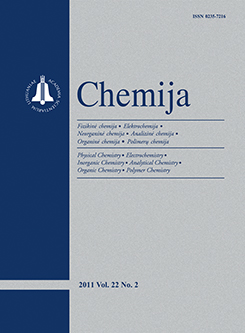 ISSN 0235-7216 ISSN 2424-4538 (online) |
2009 m. Nr. 2 Redox properties and prooxidant cytotoxicity of benzofuroxans: a comparison with nitrobenzenes
The presence of =N(→O)O- moiety in benzofuroxans may confer them the electron-accepting properties similar to those of aromatic nitrocompounds or N-oxides which are used as bioreductively activated antitumour and / or cytotoxic agents. However, the redox properties of benzofuroxans have not been characterized so far. We have studied the redox properties of eight benzofuroxans, determining the heats of formation of their free radicals (ΔHf(e–)), the peak-potentials of their electrochemical reduction in the aqueous medium at pH 7.0 (Ep, 7), and their reactivity towards a single-electron transferring flavoenzyme, ferredoxin : NADP+ reductase (FNR). We found that the reactivity of benzofuroxans towards FNR in general is similar to that of (poly)nitrobenzenes possessing analogous values of ΔHf(e–), and the benzofuroxans are reduced in a single-electron way. However, the Ep, 7 of the irreversible electrochemical reduction of benzofuroxans strongly deviated from the dependence of ΔHf(e–) of nitrobenzenes on their Ep, 7. In general, the cytotoxicity of benzofuroxans in bovine leukemia virus-transformed lamb kidney fibroblasts (line FLK) is similar to that of nitroaromatic compounds possessing the analogous values of ΔHf(e–), whereas their cytotoxicity in mice splenocytes considerably differs. This may be caused by other parallel cytotoxicity mechanisms, e. g. reactions of benzofuroxans with –SH groups. In this work, for the first time we identified benzofuroxans as redox active compounds. Preliminarily, one may conclude that the redox properties and cytotoxicity of benzofuroxans bear certain similarities (reactions with single-electron-transferring flavoenzymes) and differences (electrochemical reduction, cytotoxicity) from nitroaromatic compounds. Keywords: benzofuroxans, nitrobenzenes, electrochemical reduction, electron-accepting properties, ferredoxin : NADP+ reductase, free radicals, oxidative stress, cytotoxicity |
Issues:
2017 - Vol.28 No. 1, No. 2, No. 3, No. 4 2016 - Vol.27 No. 1, No. 2, No. 3, No. 4 2015 - Vol.26 No. 1, No. 2, No. 3, No. 4 2014 - Vol.25 No. 1, No. 2, No. 3, No. 4 2013 - Vol.24 No. 1, No. 2, No. 3, No. 4 2012 - Vol.23 No. 1, No. 2, No. 3, No. 4 2011 - Vol.22 No. 1, No. 2, No. 3, No. 4 2010 - Vol.21 No. 1, No. 2-4 2009 - Vol.20 No. 1, No. 2, No. 3, No. 4 2008 - Vol.19 No. 1, No. 2, No. 3-4 2007 - Vol.18 No. 1, No. 2, No. 3, No. 4 2006 - Vol.17 No. 1, No. 2-3, No. 4 2005 - Vol.16 No. 1, No. 2, No. 3-4 2004 - Vol.15 No. 1, No. 2, No. 3, No. 4 2003 - Vol.14 No. 1, No. 2, No. 3, No. 4 2002 - Vol.13 No. 1, No. 2, No. 3, No. 4 2001 - Vol.12 No. 1, No. 2, No. 3, No. 4 |